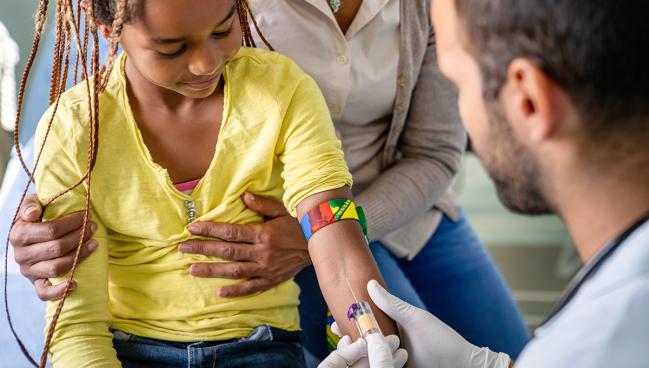USPSTF: Screening Kids for Lipid Disorders Still Needs More Data
For the third time in 15 years, the task force has given an “I” recommendation to screening, citing not enough research.

Once again, the United States Preventive Services Task Force (USPSTF) has concluded there is not enough evidence to support screening asymptomatic kids and adolescents for lipid disorders.
Published in JAMA today, a new statement and supporting evidence review don’t offer much by way of an update to the prior 2016 USPSTF position: the group gives the same “I” statement put forth 7 years ago, which itself was the same conclusion reached in 2007.
“The USPSTF concludes that the current evidence is insufficient to assess the balance of benefits and harms of screening for lipid disorders in children and adolescents 20 years or younger,” the writing group concludes.
Familial hypercholesterolemia (FH), which can cause early myocardial infarction, stroke, and death, is believed to be present in approximately one in 250-500 children, while multifactorial dyslipidemia is much more common, occurring in anywhere from 7.1% to 9.4% of children and adolescents, the task force notes. Whether screening for these disorders, and treating them, can improve outcomes was the focus of this latest USPSTF effort.
More Data (Still) Needed
In the evidence review, Janelle M. Guirguis-Blake, MD (Permanente Evidence-based Practice Center, Kaiser Permanente, Portland, Oregon), and colleagues write: “No direct evidence on the benefits or harms of pediatric lipid screening was identified. While multifactorial dyslipidemia is common, no evidence was found that treatment is effective for this condition. In contrast, FH is relatively rare; evidence shows that statins reduce lipid levels in children with FH, and observational studies suggest that such treatment has long-term benefit for this condition.”
Given these uncertainties, USPSTF member Li Li, MD, PhD, MPH (University of Virginia, Charlottesville), told TCTMD that an “I” statement is not to be interpreted as a recommendation for or against any action. “Over the period of the last few years, a few studies have been added but unfortunately, the evidence is not sufficient for us to actually come up with [a recommendation],” said Li. “This remains an I statement, meaning that [we haven't] recommended for or against screening, but instead call for more research.“
The reviewers considered 43 studies representing 491,516 subjects under the age of 20. None of these studies, they note, directly addressed screening effectiveness and harms. Ten randomized trials suggested that statins could lower cholesterol levels in FH patients, while nonstatin trials also demonstrated lipid-lowering benefits in this population. None, however, addressed the efficacy of any single drug, and none were long enough duration to assess the risk/benefit trade-off. Observational studies, on the other hand, pointed to long-term benefits on cardiovascular risk in the setting of FH. Any harms of therapy in the studies reviewed here were no different between intervention and control groups. No evidence supported a benefit of lipid-lowering medications initiated in childhood for multifactorial dyslipidemia.
To TCTMD, Li said there are four key areas he hopes research can address before the USPSTF tackles this question again. Studies, to date, have not demonstrated a long-term benefit on hard events with the early initiation of treatment, nor have they been able to look at harms and adverse events over the long term, he said. The optimal age for starting lipid-lowering therapy is not clear from the data amassed to date. Lastly, there is no evidence demonstrating that current screening tests, developed in adults, are sensitive enough to pick up FH or multifactorial dyslipidemia in children and adolescents.
Li, as well as the USPSTF in their JAMA papers, acknowledged that other professional bodies have released more strongly worded advice. “The National Heart, Lung, and Blood Institute’s Expert Panel on Integrated Guidelines for Cardiovascular Health and Risk Reduction in Children and Adolescents, the American Academy of Pediatrics’ Bright Futures program, and the multisociety Guideline on the Management of Blood Cholesterol recommend selectively screening children with a family history of cardiovascular disease or dyslipidemia or other risk factors as early as age 2 years,” they write, as well as universal screening of kids aged 9 to 11 years and 17 to 21 years.
Li stressed: “Our recommendation is different, but it's not in opposition to [other] recommendations. Instead, it's a call for research. In the meantime, in the absence of evidence, we really encourage clinicians when they’re facing the individual patient to use their judgment to decide whether to screen the patient in front of them on an individual basis.” Caregivers, he added, should be encouraged to bring any concerns they have to their physicians.
An accompanying editorial by Sarah D. de Ferranti, MD, MPH (Harvard Medical School, Boston, MA), and colleagues, makes the case for “novel and pragmatic” study designs to help fill the research void, but points to existing guidance to help clinicians making decisions today. In addition to the sources cited by the USPSTF authors, de Ferranti et al note that the American Heart Association and American College of Cardiology recommend childhood lipid screening at age 9 to 11 and again between 17 and 21, a class IIb recommendation.
“We believe that the evidence supporting specific screening for and treatment of FH in childhood is growing, and a universal screening approach to reduce the burden of premature atherosclerotic cardiovascular disease among persons with FH will likely be adopted in the future,” the editorialists predict. “In the meantime, clinicians can rely on existing guidelines and decide together with pediatric patients and their families if and when to screen for lipid disorders in childhood.”
Shelley Wood was the Editor-in-Chief of TCTMD and the Editorial Director at the Cardiovascular Research Foundation (CRF) from October 2015…
Read Full BioSources
US Preventive Services Task Force. Screening for lipid disorders in children and adolescents. USPSTF recommendation statement. JAMA. 2023;330(3):253-260.
Guirguis-Blake JM, Evans CV, Coppola EL, et al. Screening for lipid disorders in children and adolescents. Updated evidence report and systematic review for the USPSTF. JAMA. 2023;330(3):261-274.
de Ferranti SD, Moran AE, Kazi DS. Still “on the fence” about universal childhood lipid screening. The USPSTF reaffirms an I statement. JAMA. 2023;330(3):225-227.
Disclosures
- All members of the USPSTF receive travel reimbursement and an honorarium for participating in USPSTF meetings.




Comments